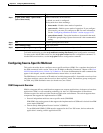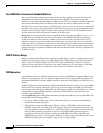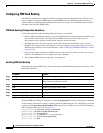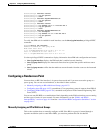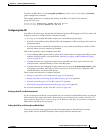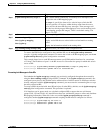
44-20
Catalyst 3560 Switch Software Configuration Guide
OL-8553-06
Chapter 44 Configuring IP Multicast Routing
Configuring IP Multicast Routing
Go to this URL to see SSM mapping configuration examples:
http://www.cisco.com/en/US/products/sw/iosswrel/ps5207/products_feature_guide09186a00801a6d6f.
html
Configuring DNS-Based SSM Mapping
To configure DNS-based SSM mapping, you need to create a DNS server zone or add records to an
existing zone. If the routers that are using DNS-based SSM mapping are also using DNS for other
purposes, you should use a normally configured DNS server. If DNS-based SSM mapping is the only
DNS implementation being used on the router, you can configure a false DNS setup with an empty root
zone or a root zone that points back to itself.
Beginning in privileged EXEC mode, follow these steps to configure DNS-based SSM mapping:
Configuring Static Traffic Forwarding with SSM Mapping
Use static traffic forwarding with SSM mapping to statically forward SSM traffic for certain groups.
Step 6
end Return to privileged EXEC mode.
Step 7
show running-config Verify your entries.
Step 8
copy running-config startup-config (Optional) Save your entries in the configuration file.
Command Purpose
Command Purpose
Step 1
configure terminal Enter global configuration mode.
Step 2
ip igmp ssm-map enable Enable SSM mapping for groups in a configured SSM range.
Step 3
ip igmp ssm-map query dns (Optional) Enable DNS-based SSM mapping.
By default, the ip igmp ssm-map command enables DNS-based SSM
mapping. Only the no form of this command is saved to the running
configuration.
Note Use this command to re-enable DNS-based SSM mapping if
DNS-based SSM mapping is disabled.
Step 4
ip domain multicast domain-prefix (Optional) Change the domain prefix used by the switch for DNS-based
SSM mapping.
By default, the switch uses the ip-addr.arpa domain prefix.
Step 5
ip name-server server-address1
[server-address2... server-address6]
Specify the address of one or more name servers to use for name and
address resolution.
Step 6
Repeat Step 5 to configure additional
DNS servers for redundancy, if required.
—
Step 7
end Return to privileged EXEC mode.
Step 8
show running-config Verify your entries.
Step 9
copy running-config startup-config (Optional) Save your entries in the configuration file.




